Potřebujeme váš souhlas k využití jednotlivých dat, aby se vám mimo jiné mohly ukazovat informace týkající se vašich zájmů. Souhlas udělíte kliknutím na tlačítko „OK“.
ASTM D7624-10
Standard Test Method for Condition Monitoring of Nitration in In-Service Petroleum and Hydrocarbon-Based Lubricants by Trend Analysis Using Fourier Transform Infrared (FT-IR) Spectrometry
Automaticky přeložený název:
Standardní zkušební metoda pro sledování stavu nitrace do dalšího ropu a na bázi uhlovodíku, maziva podle analýzy trendů Použití Fourier Transform Infrared (FT-IR) spektrometrie
NORMA vydána dne 1.8.2010
Informace o normě:
Označení normy: ASTM D7624-10
Poznámka: NEPLATNÁ
Datum vydání normy: 1.8.2010
Kód zboží: NS-38850
Počet stran: 4
Přibližná hmotnost: 12 g (0.03 liber)
Země: Americká technická norma
Kategorie: Technické normy ASTM
Kategorie - podobné normy:
Tekutá paliva
Maziva, průmyslové oleje a odpovídající výrobky
Anotace textu normy ASTM D7624-10 :
Keywords:
condition monitoring, differential trend analysis, direct trend analysis, Fourier transform infrared, FT-IR, hydrocarbon-based lubricants, infrared, in-service petroleum lubricants, IR, lubricants, nitration, oils, ICS Number Code 75.100 (Lubricants, industrial oils and related products), 75.160.20 (Liquid fuels)
Doplňující informace
| Significance and Use | ||||||||||||||||||||
|
There is a wide variety of nitration compounds that may be produced and accumulate when oils react with gaseous nitrates formed during the engine combustion process. These nitration products may increase the viscosity, acidity and insolubles in the oil, which may lead to ring sticking and filter plugging. Monitoring of nitration products is therefore an important parameter in determining overall machinery health and should be considered in conjunction with data from other tests such as atomic emission (AE) and atomic absorption (AA) spectroscopy for wear metal analysis (Test Method D5185), physical property tests (Test Methods D445, D6304, and D2896), and other FT-IR oil analysis methods for oxidation (Test Method ), sulfate by-products (Test Method D7415), additive depletion (Test Method D7412), and breakdown products and external contaminants (Practice E2412), which also assess elements of the oil’s condition. (1-6) |
||||||||||||||||||||
| 1. Scope | ||||||||||||||||||||
|
1.1 This test method covers monitoring nitration in gasoline and natural gas engine oils as well as in other types of lubricants where nitration by-products may form due to the combustion process or other routes of formation of nitration compounds. 1.2 This test method uses FT-IR spectroscopy for monitoring build-up of nitration by-products in in-service petroleum and hydrocarbon-based lubricants as a result of normal machinery operation. Nitration levels in gasoline and natural gas engine oils rise as combustion by-products react with the oil as a result of exhaust gas recirculation or a blow-by. This test method is designed as a fast, simple spectroscopic check for monitoring of nitration in in-service petroleum and hydrocarbon-based lubricants with the objective of helping diagnose the operational condition of the machine based on measuring the level of nitration in the oil. 1.3 Acquisition of FT-IR spectral data for measuring nitration in in-service oil and lubricant samples is described in Practice D7418. In this test method, measurement and data interpretation parameters for nitration using both direct trend analysis and differential (spectral subtraction) trend analysis are presented. 1.4 This test method is based on trending of spectral changes associated with nitration in in-service petroleum and hydrocarbon-based lubricants. For direct trend analysis, values are recorded directly from absorption spectra and reported in units of 100*absorbance per 0.1 mm pathlength (or equivalently absorbance units per centimetre). For differential trend analysis, values are recorded from the differential spectra (spectrum obtained by subtraction of the spectrum of the reference oil from that of the in-service oil) and reported in units of 100*absorbance per 0.1 mm pathlength (or equivalently absorbance units per centimetre). Warnings or alarm limits can be set on the basis of a fixed maximum value for a single measurement or, alternatively, can be based on a rate of change of the response measured. (1) In either case, such maintenance action limits should be determined through statistical analysis, history of the same or similar equipment, round robin tests or other methods in conjunction with the correlation of nitration changes to equipment performance. Note 1—It is not the intent of this test method to establish or recommend normal, cautionary, warning or alert limits for any machinery. Such limits should be established in conjunction with advice and guidance from the machinery manufacturer and maintenance group. 1.5 This test method is for petroleum and hydrocarbon-based lubricants and is not applicable for ester-based oils, including polyol esters or phosphate esters. 1.6 The values stated in SI units are to be regarded as standard. No other units of measurement are included in this standard. 1.6.1 Exception—The unit for wave numbers is cm-1. 1.7 This standard does not purport to address all of the safety concerns, if any, associated with its use. It is the responsibility of the user of this standard to establish appropriate safety and health practices and determine the applicability of regulatory limitations prior to use. |
||||||||||||||||||||
| 2. Referenced Documents | ||||||||||||||||||||
|
Podobné normy:
Historická
15.9.2013
Historická
1.8.2007
Historická
15.4.2012
Historická
1.10.2011
Historická
1.12.2012
Historická
1.5.2014
Doporučujeme:
Aktualizace zákonů
Chcete mít jistotu o platnosti užívaných předpisů?
Nabízíme Vám řešení, abyste mohli používat stále platné (aktuální) legislativní předpisy.
Chcete vědět více informací? Podívejte se na tuto stránku.


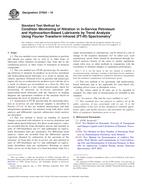
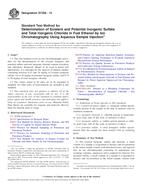 ASTM D7328-13
ASTM D7328-13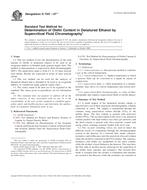 ASTM D7347-07e1
ASTM D7347-07e1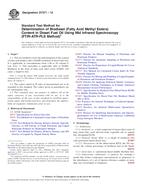 ASTM D7371-12
ASTM D7371-12 ASTM D7398-11
ASTM D7398-11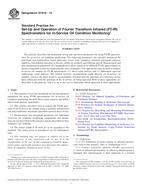 ASTM D7418-12
ASTM D7418-12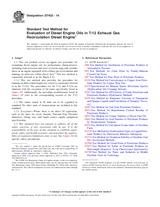 ASTM D7422-14
ASTM D7422-14
 Cookies
Cookies
